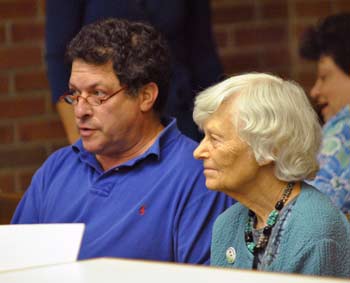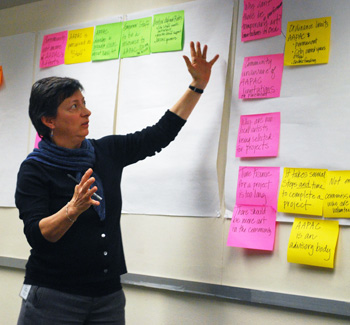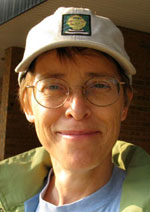Ann Arbor park advisory commission meeting (May 21, 2013): The meeting featured a briefing on a project to install rain gardens at Arbor Oaks Park, part of a broader effort to address drainage and flooding problems in the Bryant neighborhood in southeast Ann Arbor.

Bob Galardi was elected chair of the budget & finance committee for the Ann Arbor park advisory commission at PAC’s May 21, 2013 meeting. (Photos by the writer.)
Jerry Hancock, the city’s stormwater and floodplain programs coordinator, described the project, which is being paid for out of the city’s stormwater utility fund – not the parks and recreation budget. It will involve regrading the perimeter of the park in the fall, then putting in native plants next spring. Soil excavated to create the rain gardens will be used to elevate the park’s central lawn area, which often has standing water following heavy rains. The work will be done prior to improvements planned for the park’s playground next year.
Later in the meeting, commissioners voted to recommend awarding a contract for roof replacement at the Mack indoor pool, located within the Ann Arbor Open school near the corner of Miller and Brooks. The recommendation is to select Pranam GlobalTech Inc., which put in the low bid of $193,000. A 10% construction contingency brings the project’s budget to $212,300, with a portion of that amount to be paid for by the public schools.
Also recommended was using $8,280 from the public market fund to upgrade a surface parking lot – known as the “sand lot” – on the Fourth Avenue side of the farmers market. The paving is viewed as a short-term solution, pending longer-term improvements expected at the market in a few years.
Commissioners also elected Bob Galardi as chair of PAC’s budget & finance committee. He replaces Tim Doyle as committee chair, following the end of Doyle’s term on PAC earlier this month. Jen Geer – Doyle’s replacement on PAC – was confirmed by the city council the previous evening but did not attend PAC’s May 21 meeting. Geer has worked with Galardi and councilmember Christopher Taylor – an ex-officio member of PAC – in another capacity, in the performing arts. Most recently, she was executive producer for the Ann Arbor in Concert production of Ragtime, performed at Michigan Theater on May 18. Both Taylor and Galardi were lead performers in that show.
Updates during PAC’s May 21 meeting covered a range of topics, including news that bids for construction of the new skatepark came in a little higher than anticipated. Parks staff and skatepark designer Wally Hollyday will be reviewing the bids to see what options are available. Parks and recreation manager Colin Smith reported that at PAC’s June 18 meeting, commissioners will be presented with a resolution to award a construction contract, as well as an agreement between the city and the Friends of the Ann Arbor Skatepark related to operating the skatepark.
Other updates from Smith included the fact that parks staff is gearing up for Memorial Day weekend, with the opening of the city’s outdoor pools. He also highlighted the completed renovations of ball fields at Veterans Memorial Park, West Park and Southeast Area Park, and improvements made at Liberty Plaza. In addition to removing some bushes there, he said, “we also removed all sorts of things that were in the bushes, which are no longer there – and I’m glad they’re not.”
Other brief reports were given regarding work of PAC’s dog park and downtown park subcommittees, and public forums for the North Main-Huron River task force. Public commentary focused on input from the Library Green Conservancy, which is advocating for a park or public space atop the city’s Library Lane parking structure. [Full Story]







